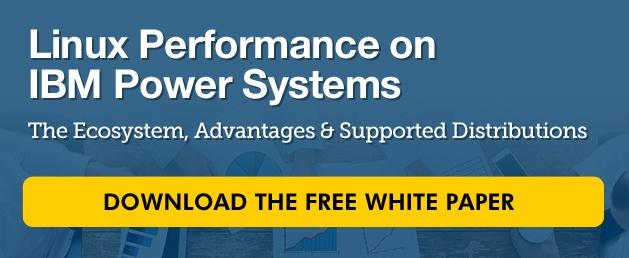Back in 2013, IBM renewed its commitment to Linux by pledging to invest $1 billion to improve the Linux OS on Power Systems. This investment helps to support 400 independent software vendors offering over 1,000 applications as well as 2,500 open-source applications.
IBM’s ongoing support of Linux has encouraged the development of many Linux distributions under the collaborative spirit of the open source philosophy. Because Linux is an open source operating system, users can distribute it freely and adapt it to meet different business needs. This has made Linux a leading operating system. Moreover, a variety of options gives companies freedom of choice when choosing a Linux operating system to adopt.
However, with so many versions available, choosing the right Linux distribution can be difficult. One major distinction that makes some Linux distributions stand out is their support of IBM POWER. These distributions have responded to IBM’s investment in Linux by making a commitment to POWER.
For example, Red Hat, SUSE, and Ubuntu have all committed to supporting IBM Power Systems with the same release and patch cycle that they follow for their X86 releases.
Here is a closer look at the advantages each of these Linux distributions offers by supporting IBM POWER.
Virtualization and Cloud with Red Hat
Red Hat has been working with IBM for over 16 years to build optimized infrastructures using open-source hardware and software. Most notably, Red Hat Enterprise Virtualization and Red Hat Cloud enable companies to run big data workloads while using fewer servers.
Red Hat Enterprise Virtualization for POWER is built on a KVM hypervisor for centralized management of virtual machines (VMs). Companies can increase their scalability while managing hundreds of hosts and VMs through a single pane of glass.
At IBM Edge in 2016, IBM announced that they would be working with Red Hat to develop next-generation cloud platforms enhanced by Power Systems technology. The partnership will promote hybrid cloud, adding to the private infrastructure-as-a-service that Red Hat Cloud already offers.
In 2015, Red Hat released Enterprise Linux (7.1) for POWER, providing little endian support for POWER8. The new release allowed companies to migrate applications developed for x86 to POWER easily. Multi-threads, greater cache, and larger bandwidth met the performance needs of advanced data analytics.
SAP HANA with SUSE
SUSE showed their commitment to IBM POWER by making SUSE Linux Enterprise Server the first Linux operating system to run on IBM Power Systems. Recently, SUSE introduced Linux Enterprise 12 SP2. The release enables virtualization for both the cloud and on-premises infrastructures.
In addition, SP2 allows companies to migrate easily to SAP HANA. With SAP HANA, companies can use in-memory database technologies to gain real-time and actionable insights from data.
By working with IBM Power Systems, SUSE offers high availability and disaster recovery for SAP HANA through frequent replication. Limited downtime and rapid input/output rates empower businesses to use high-performance data analytics.
Flexibility and Reliability with Ubuntu
Ubuntu enables businesses to develop a flexible workplace that embraces mobile and cloud. With Ubuntu, the same code base can run across devices from desktop to mobile. A mobile-first strategy helps to ensure that a remote workforce gets the resources and support they need. Since early in their relationship with IBM, Ubuntu has supported cloud deployments with Ubuntu Server for cloud, enabling companies to migrate to OpenStack for private cloud.
Ubuntu also empowers companies to harness high-performance computing through their POWER8 Coherent Accelerator Processor Interface (CAPI). The acceleration rates created by CAPI provide the performance needed to take advantage of technological innovations such as big data analytics, mobile, social, cloud, and machine learning.
Along with flexibility, Ubuntu offers reliability via their Long-term Support version. Your business gains peace-of-mind with guaranteed support and patching for at least 7 years.
Making the Move Toward Higher Performance
A 2015 study conducted by Forrester Consulting found that companies are moving away from x86 servers because of the increasing demands of high-performance applications. Organizations that want to take advantage of the valuable insights offered by advanced analytics should move towards Linux distributions that are compatible with IBM POWER.
The performance speed and memory capacity of POWER meets today’s high-performance computing demands. Open source Linux encourages innovations that enable developers to customize the operating system to meet different needs. Choosing the right POWER-compatible Linux distribution is a matter of matching its unique features to your business goals.
As Ubuntu, Red Hat, and SUSE continue to develop products designed to run on IBM POWER, you need a technology partner who is up to date on the latest innovations. ABC Services is a Premier IBM Business Partner who can help you navigate the Linux distribution market and make the correct choice to meet your goals.
Unleash your company’s full potential. Choose a Linux distribution that takes advantage of the high-performance capabilities of IBM Power Systems.
